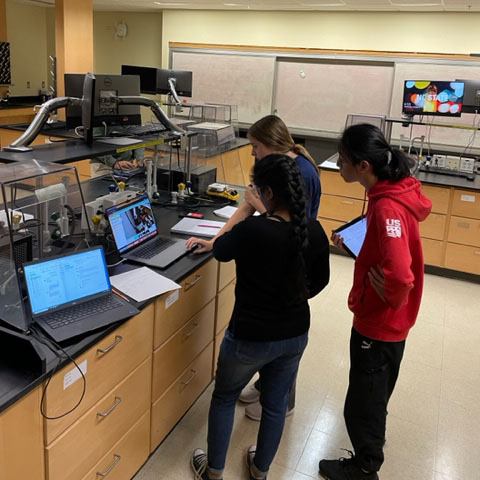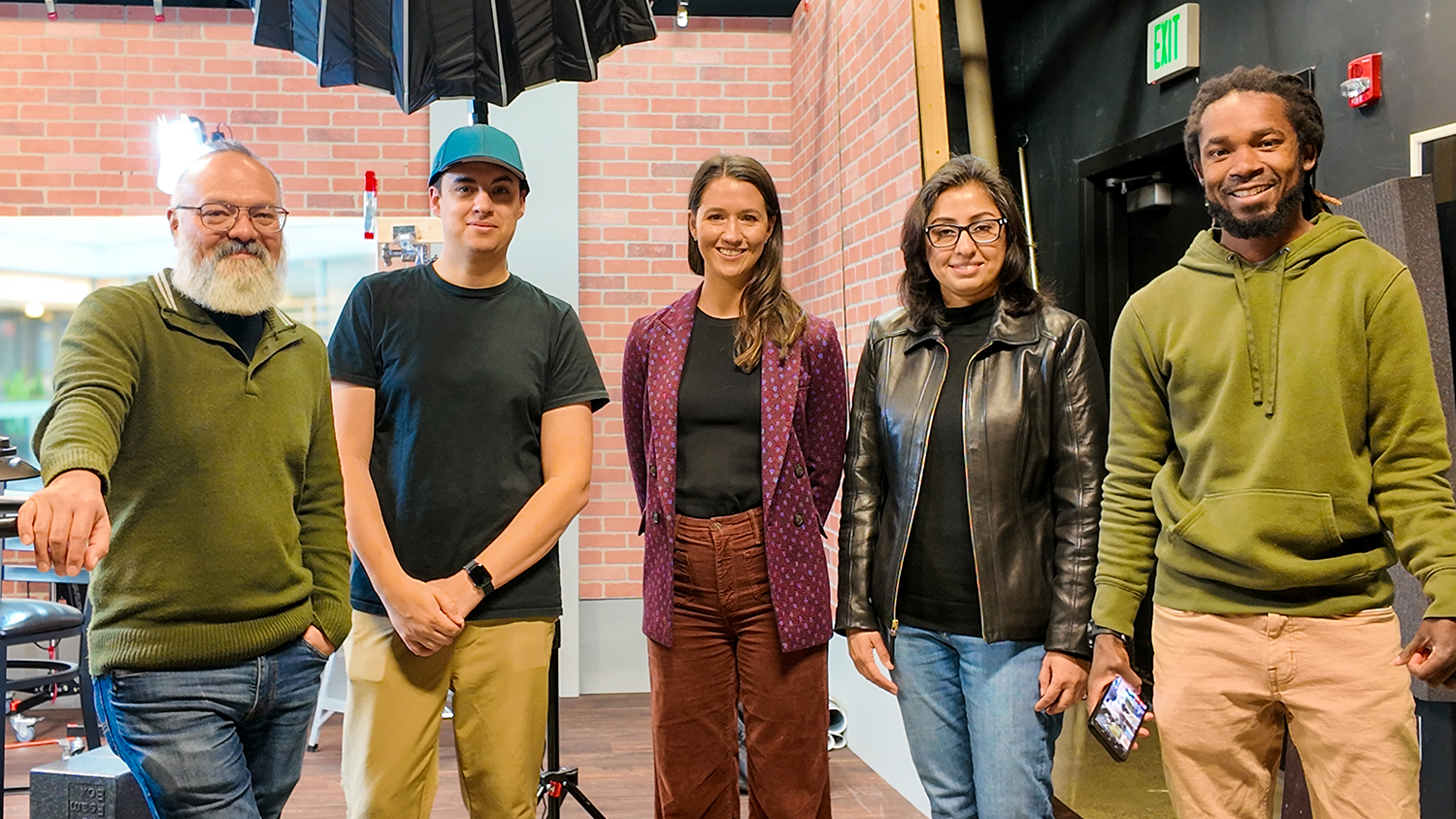More and more NC State students have a need to discern how to thrive in their courses via a virtual or remote environment. In turn, instructors continue to fine tune teaching methodologies to provide the most successful outcomes possible for all students, regardless of where a student might be located.
One specific example is within the Department of Chemistry, where faculty and staff prepare students to put their learning into practice through hands-on research about cutting edge topics. Through organic chemistry labs, students learn to use and combine specific safety protocols and lab techniques. These labs can be challenging environments.
Some students, however, might find themselves in circumstances that go beyond the typical learning challenges. For example, some students might be interacting with unfamiliar equipment in a lab with time constraints, which can be intimidating. Other students might not have access to the lab because of military deployment, disability or distance learning. And for some students, working within the lab environment might be potentially harmful due to a physical condition or chemical sensitivity.
Although attempts to replicate the lab experience in a video or using virtual reality (VR) have helped, they lack key components of practical laboratory courses. Those resources don’t emphasize helping students interpret imperfect results, troubleshoot reactions and experimental setups, or reason through varied and unexpected outcomes.
Instructors realized that a method was needed to allow students a “hands on” experience without actually having to be inside the lab itself.
Using a DELTA Grant to Meet the Need
Professor Aram Amassian, College of Engineering, and Associate Professor Ryan Chiechi, College of Sciences, worked together as Principal Investigators (PIs) with a team of DELTA specialists using a DELTA Exploratory Grant to meet this specific instructional need.
To begin, the team reviewed existing solutions like a VR laboratory space and the Thin Layer Chromatography (TLC) lab, so that students could complete hands-on work remotely using a robotic arm serving as their “hands.”
“This particular lab — the Rob-O-Chem lab — is well suited for this project, as it depends heavily on manipulating tubes physically,” Amassian explained. “Additionally, the resulting TLC relates to variables associated with the physical preparation and manipulation of real-world objects. TLC also does not pose any safety hazards and does not require specialized or sophisticated equipment, which facilitates scaling and disseminating the adapted laboratory course.”
Using this technique allows those chemistry students who cannot physically enter the lab space to still engage in the trial and error that is fundamental to learning how to prepare and interpret results. The virtually controlled robotic arm provides a more flexible learning opportunity for more students.
Defining the Project Goals
For this grant, the project goals for the team were multi faceted:
- Explore and demonstrate the capabilities of robotics in the lab to mimic an authentic experience for students.
- Create a virtual approach that mimics an authentic lab experience and provides instructionally meaningful content, for example following user mistakes or allowing key decision points.
- Establish a secure, authenticated and extensible API connection between a dedicated lab computer and a purpose-built TLC workstation with an integrated robotic arm in the lab.
- Design a user interface that provides for visualization and interaction with the TLC workstation and the robotic arm.
The team used the robotic arm within the lab — which they eventually named Rob-O-Chem — to execute the TLC experiment that is performed in CH 222: Organic Chemistry I Lab. Using a dedicated computer within the lab space, the team established a secure, authenticated and extensible API connection with the robotic arm. An interface was also developed that allowed students to visualize and interact with the TLC workstation and the robotic arm.

Using the Rob-O-Chem technology via the web client, students could remotely control the equipment and manipulate variables, analyze results in real time, and practice the technique. Specifically, students could run through a simulation of the most nuanced, error-prone part of the lab that required using a tube filled with a solution to precisely mark a plate for the experiment. Students could retry this procedure as many times as needed by tapping on the web interface and then choosing to submit this “performance” to the robot, which would repeat their movements within fractions of millimeters and use their exact timing down to the millisecond. This approach provided additional opportunities to learn the technique while lowering the stakes during the lab. The simulation component was also available outside of student lab time so they could prepare in advance.

Secondary Outcome: Raw Footage Becomes Usable Video
While working with the grant project, DELTA’s Director of Digital Media Innovation Mike Cuales requested footage of the first test of the Rob-O-Chem lab technology used during the grant. Because the technology involved was in a pilot stage, capturing footage of the students using it would be critical both as documentary evidence of the work achieved as well as how the technology might be used going forward.
John Gordon, DELTA’s associate director of instructional media production, took the suggestion for the footage a step further. Gordon proposed using the footage to create a short video that told the story of the technology and its future benefits.
Chiechi was excited to have the opportunity to gain an additional outcome from the grant.
“When John approached me with the idea regarding the video, I was enthusiastic about the possibilities,” Chiechi said. “I have difficulty getting people to understand the overall concepts of the Rob-O-Chem lab and the benefits of the technology. Although Rob-O-Chem is not an available technology, we can use the video to show what we accomplished, to explain the underlying motivation for automating undergraduate laboratory courses with robotics (which was the topic of the original DELTA Grant), and to promote the project in the pursuit of future financial support for continued efforts.”
Gordon agreed with Chiechi’s assessment of how the video, as a byproduct of the original grant, can be useful in the future.
“The video can be used on websites, in emails, or in presentations,” Gordon explained. “The technology developed during the pilot is a good first step but more research is needed to perfect it. Sharing the video can help explain the benefits of the technology and hopefully generate more interest in funding the necessary research.”
According to Chiechi, the DELTA team was “all in” in their willingness to help make this project as successful as possible.
“Everyone from the DELTA side was absolutely amazing and put in the extra effort that was above and beyond our expectations from the grant,” Chiechi said. “We are incredibly happy with the results and can’t wait to share them!”
DELTA Grant project team members for this grant included:
- Aram Amassian, Professor of Materials Science and Engineering
- Ryan Chiechi, Associate Professor of Chemistry
- Kim Gervase, Director, Strategic Education and Industry Partnerships, Organic and Carbon Electronics Laboratories
- Cassie Lilly, Associate Teaching Professor
- Joe Schroedl, Undergraduate Research Assistant, Amassian Research Group
- Varsha Verma, Graduate Student
- Christine Belledin, Project Lead
- David Tredwell, Team Lead, Multimedia Development
- Stephen Waddell, Immersive Media Developer
- Jessica White, Senior Instructional Designer
DELTA contributors included:
- Téa Blumer, Lead Multimedia Designer
- Michael Castro, Lead Instructional Media Designer/Developer
- John Gordon, Associate Director, Instructional Media Production
- Relly Moorer, Cinematographer and Post-Production Specialist
- Andrew Wiedner, Multimedia/Web Developer
- Chris Willis, Assistant Director, Research and Analysis
- Donnie Wrights, Associate Director, Educational Media Design
Learn more about DELTA Grants and how to apply.
- Categories:




